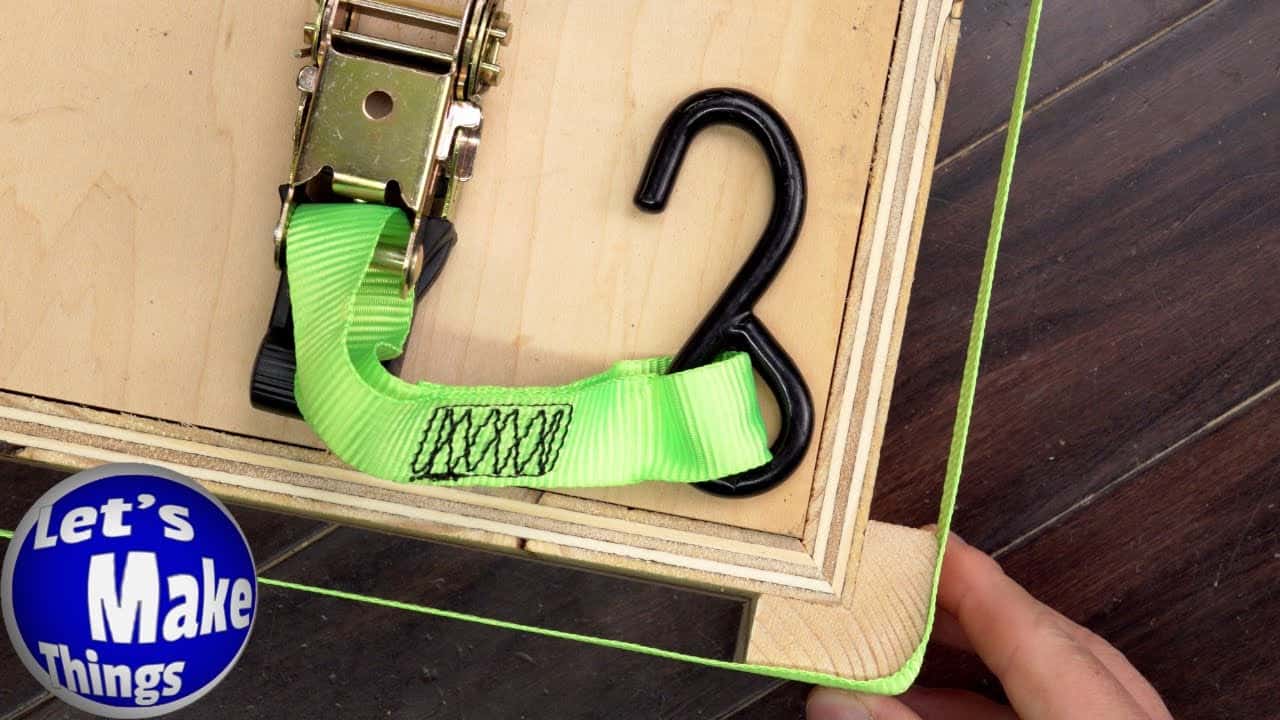This project was built and designed by Rob from Let’s Make Things.
It’s a simple, practical shop hack that turns a standard ratchet strap into a highly effective band clamp—no glue, sewing, or custom parts required.
If you’ve been considering buying a ratcheting band clamp for miters or picture frames, this approach offers a cheaper and arguably better alternative using tools and materials many already have on hand.
Watch the full video and subscribe to Rob’s channel:
Why This Hack Is So Useful
Band clamps are great for gluing up frames, mitered boxes, and anything that needs even pressure around the perimeter. But store-bought versions can be expensive and often rely on small plastic corner pieces that don’t always play nicely with delicate corners or wet glue.
Rob’s method solves both of those problems. It uses a standard cargo ratchet strap, a bit of clever knot work, and a custom-cut wooden corner block to create a clamping setup that’s strong, reusable, and shop-tested.
Materials and Tools Required
The materials are basic and likely already in your garage or shop. You’ll need:
- A nylon ratchet strap (cargo strap style)
- A way to cut the strap cleanly (sharp scissors or a utility knife)
- A lighter or heat source to seal the cut ends
- A small wood offcut for the corner block
There’s no sewing involved. No glue. No 3D printing. This hack is about modifying what you already have in a smart and reversible way.
How It Works
The hack starts by separating the ratchet from the strap. Rob then trims the strap to a workable length, sealing the edges with a heat source to prevent fraying.
The key feature is a friction-locking loop. Instead of stitching or gluing, the strap is doubled back and passed through itself, relying on the compression of the nylon fibers to hold under tension. Once threaded through and secured, the loop is tightened using the ratchet just like it would be for cargo.
This creates a fully functional band clamp—easy to adjust, simple to remove, and strong enough for most miter glue-ups.
Replacing Plastic Corners with Wood
Commercial band clamps often include plastic corner pieces that are meant to protect the workpiece and keep the strap aligned. In practice, these can actually get in the way. They often stick to glue, dig into soft woods, or fold during tightening.
Rob’s fix is to make a corner block out of scrap wood. A small notch is cut into one side to hold the strap in place and distribute pressure evenly across the joint. This makes for cleaner glue-ups and avoids damaging delicate corners.
To prevent the block from accidentally becoming part of the glue-up, Rob applies clear packing tape inside the notch. This creates a non-stick surface and makes cleanup easy.
Practical Assembly Tips
Before using the clamp on a real project, Rob suggests testing the strap and knot on scrap material. This ensures the loop holds under pressure and the ratchet tightens smoothly without slipping.
When trimming the strap, use a sharp blade and immediately seal the end with a lighter or torch. Do this away from flammable surfaces and let the nylon cool before handling it.
When tightening the ratchet, avoid overdoing it. Too much force can squeeze glue out or deform delicate joints. Just enough tension to close the gap and hold it firm is all that’s needed.
Adjusting the Design for Flexibility
The wooden corner block can be customized to match the size of your project. Having a few different lengths and notch depths on hand makes it easier to get the perfect fit across boxes, picture frames, or irregular shapes.
You can even create a small kit of ratchet straps and wood blocks for future projects. With just a few variations, you’ll have a flexible clamping system ready for just about any small to mid-size glue-up.
When to Use This Instead of Buying a Clamp
This hack is ideal for anyone doing occasional glue-ups or trying to minimize tool spending. It’s a solid option for small shops, mobile setups, or new woodworkers who aren’t ready to invest in specialized clamps.
For those who do a lot of mitered box work or production-level assembly, a purpose-built ratcheting band clamp may still make sense. But even then, the wooden corner blocks Rob demonstrates are an upgrade worth considering—even if used alongside a store-bought system.
Final Thoughts and Shop Philosophy
What makes this project so useful isn’t just the savings or simplicity—it’s the mindset. Rob shows how thinking creatively with common tools can solve everyday problems in the shop.
By converting a basic strap into a functional clamp, and improving on the weak points of commercial designs, Rob offers a better way to glue miters and frames. It’s quick, inexpensive, and easy to adapt for future projects.
Watch the full video and subscribe to Rob’s channel:
